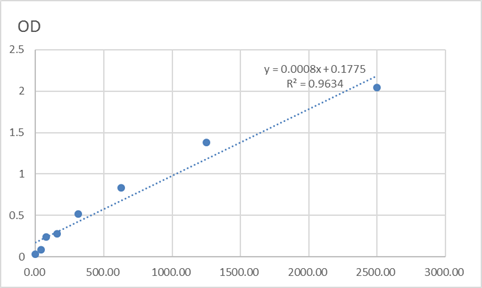Total Clock Cell-Based Colorimetric ELISA Kit
- 货号:KA3460C
- 应用:ELISA
- 种属:Human;Mouse;Rat
- 基因名称:
- CLOCK
- Human Gene Id:
- 9575
- Human Swiss Prot No:
- O15516
- Mouse Swiss Prot No:
- O08785
- Rat Swiss Prot No:
- Q9WVS9
- 储存:
- 2-8°C/6 months
- 其他名称:
- Circadian locomoter output cycles protein kaput (hCLOCK) (EC 2.3.1.48) (Class E basic helix-loop-helix protein 8) (bHLHe8)
- 检测方法:
- Colorimetric
- 背景:
- catalytic activity:Acetyl-CoA + histone = CoA + acetylhistone.,function:ARNTL/2-CLOCK heterodimers activate E-box element (3'-CACGTG-5') transcription of a number of proteins of the circadian clock. Activates transcription of PER1 and PER2. This transcription is inhibited in a feedback loop by PER and CRY proteins. Has intrinsic histone acetyltransferase activity and this enzymatic function contributes to chromatin-remodeling events implicated in circadian control of gene expression (By similarity). Acetylates primarily histones H3 and H4 (By similarity). Acetylates also a non-histone substrate: ARNTL.,miscellaneous:CLOCK-ARNTL double mutations within the PAS domains result in syngernistic desensitization to high levels of CRY on repression of CLOCK-ARNTL transcriptional activity of PER1 and disrupt circadian rhythmicity.,PTM:Phosphorylation is dependent on CLOCK-ARNTL heterodimer formation.,similarity:Contains 1 basic helix-loop-helix (bHLH) domain.,similarity:Contains 1 PAC (PAS-associated C-terminal) domain.,similarity:Contains 2 PAS (PER-ARNT-SIM) domains.,subcellular location:Shuffling between the cytoplasm and the nucleus is under circadian regulation and is ARNTL-dependent. Phosphorylated form located in the nucleus.,subunit:Component of the circadian clock oscillator which includes the CRY proteins, CLOCK or NPAS2, ARNTL or ARNTL2, CSNK1D and/or CSNK1E, TIMELESS and the PER proteins. Efficient DNA binding requires dimerization with another bHLH protein. Heterodimerization with ARNTL is required for E-box-dependent transactivation, for CLOCK nuclear translocation and degradation, and, for phosphorylation of both CLOCK and ARNTL. Interaction with PER and CRY proteins requires translocation to the nucleus. Interaction of the CLOCK-ARNTL heterodimer with PER or CRY inhibits transcription activation. Binds weakly ARNTL and ARNTL2 to form heterodimers which bind poorly to the E-box motif.,tissue specificity:Expressed in all tissues examined including spleen, thymus, prostate, testis, ovary, small intestine, colon, leukocytes, heart, brain, placenta, lung, liver, skeletal muscle, kidney and pancreas. Highest levels in testis and skeletal muscle. Low levels in thymus, lung and liver. Expressed in all brain regions with highest levels in cerebellum. Highly expressed in the suprachiasmatic nucleus (SCN).,
- 功能:
- transcription, regulation of transcription, DNA-dependent, regulation of transcription from RNA polymerase II promoter,circadian rhythm, response to radiation, response to light stimulus, response to abiotic stimulus, photoperiodism,entrainment of circadian clock, positive regulation of biosynthetic process, positive regulation of macromolecule biosynthetic process, positive regulation of macromolecule metabolic process, positive regulation of gene expression,positive regulation of cellular biosynthetic process, regulation of circadian rhythm, regulation of transcription, positive regulation of transcription, DNA-dependent, positive regulation of nucleobase, nucleoside, nucleotide and nucleic acid metabolic process, positive regulation of transcription, positive regulation of transcription from RNA polymerase II promoter, rhythmic process, positive regulation of nitrogen compound metabol
- 细胞定位:
- Nucleus . Cytoplasm . Cytoplasm, cytosol . Shuttling between the cytoplasm and the nucleus is under circadian regulation and is ARNTL/BMAL1-dependent. Phosphorylated form located in the nucleus while the nonphosphorylated form found only in the cytoplasm. Sequestered to the cytoplasm in the presence of ID2 (By similarity). Localizes to sites of DNA damage in a H2AX-independent manner. .
- 组织表达:
- Hair follicles (at protein level). Expressed in all tissues examined including spleen, thymus, prostate, testis, ovary, small intestine, colon, leukocytes, heart, brain, placenta, lung, liver, skeletal muscle, kidney and pancreas. Highest levels in testis and skeletal muscle. Low levels in thymus, lung and liver. Expressed in all brain regions with highest levels in cerebellum. Highly expressed in the suprachiasmatic nucleus (SCN).
- June 19-2018
- WESTERN IMMUNOBLOTTING PROTOCOL
- June 19-2018
- IMMUNOHISTOCHEMISTRY-PARAFFIN PROTOCOL
- June 19-2018
- IMMUNOFLUORESCENCE PROTOCOL
- September 08-2020
- FLOW-CYTOMEYRT-PROTOCOL
- May 20-2022
- Cell-Based ELISA│解您多样本WB检测之困扰
- July 13-2018
- CELL-BASED-ELISA-PROTOCOL-FOR-ACETYL-PROTEIN
- July 13-2018
- CELL-BASED-ELISA-PROTOCOL-FOR-PHOSPHO-PROTEIN
- July 13-2018
- Antibody-FAQs



